07 OCT. 2024
OYAK HORSE celebrates 7.5 million engines produced
– OYAK HORSE plant in Bursa, Türkiye achieves milestone of 7.5 million engines produced.
– Approximately 100 jobs created to support new third shift, growing facility’s workforce by 10%
– HORSE is a division of Horse Powertrain, a global leader in hybrid and combustion powertrain solutions across 17 plants and 5 R&D centres
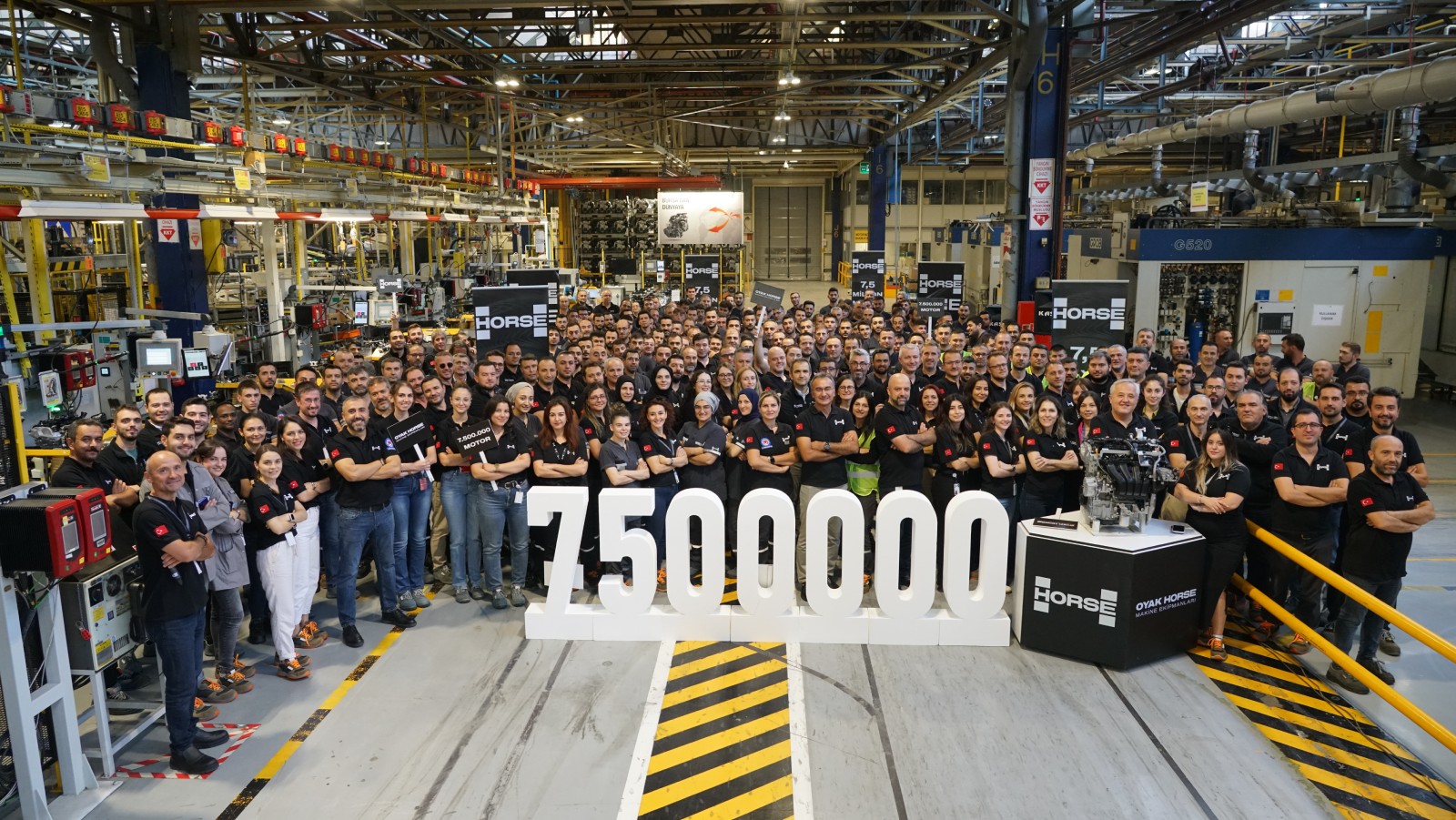
HORSE, a division of Horse Powertrain and a leader in innovative and low emissions powertrain systems, today celebrates a major milestone of 7.5 million engines produced at the OYAK HORSE plant in Bursa, Türkiye.
Coinciding with this milestone, OYAK HORSE has created approximately 100 new jobs, growing its workforce by 10%. These new jobs will support the creation of a third daily shift at the plant. This new shift will enable the plant to further scale production from the over 1,500 engine units produced daily, following a 38% rise in output between 2023 and 2024 in the face of continued growth in hybrid engine demand.
Gökhan Deniz, GM at OYAK HORSE Türkiye, said: “This achievement is a reflection of the dedication and hard work of our team over the past 54 years. I would like to thank all our colleagues, stakeholders and suppliers who have contributed to our progress since the beginning. In Türkiye, the HORSE team is committed and ready to play a key role in providing mobility solutions that support decarbonisation and facilitate the global energy transition.”
Hybrid engine production at OYAK HORSE
The landmark 7.5 millionth engine produced at OYAK HORSE will be a HR16 Gen3 hybrid engine, a 4-cylinder, 1.6-liter gasoline engine engineered for optimal efficiency and performance in hybrid vehicles.
The engine boasts a maximum power output of 69kW at 5,600rpm, and is designed to meet the demands of both EU and global markets. The engine fully complies with EURO 6D FULL emissions standards, emphasising its commitment to lower emissions.
Driving Solutions for Global Automotive Challenges
OYAK HORSE specialises in developing low-emission internal combustion and hybrid engines and features a high-pressure aluminium injection facility, dedicated engine and gearbox departments, and an R&D center.
Spanning 81,000m², the plant operates three shifts with a workforce of approximately 1,000 employees and exports about 75% of its production abroad. In addition to manufacturing, OYAK HORSE enhances its contribution to the automotive industry through various services, including prototyping, machining, metrology, emissions testing, and training programs.
HORSE: a leader in Innovative Power Solutions
HORSE was created to provide highly efficient, low-emission engines, transmissions and technologies to meet the varying power generation needs around the world. HORSE is a truly global company, with eight production plants across seven countries, three R&D centres and a head office based in Madrid, Spain. The company produces 3.2 million units per year for its customers around the world.
DOWNLOAD DOCUMENT
19 SEP. 2024
HORSE starts plug-in hybrid engine production at Valladolid facility
– HORSE Powertrain Solutions begins producing 152PS 1.2-litre, 3-cylinder turbocharged engine to be used in Renault Rafale E-Tech Hybrid
– Production at HORSE Valladolid plant initially targets 1,200 units per month
– Investment in Valladolid for new PHEV engine production totals €4 million and will create 345 jobs
– HORSE is a division of HORSE Powertrain Limited, a global leader in hybrid and combustion powertrain solutions across 17 plants and 5 R&D centres
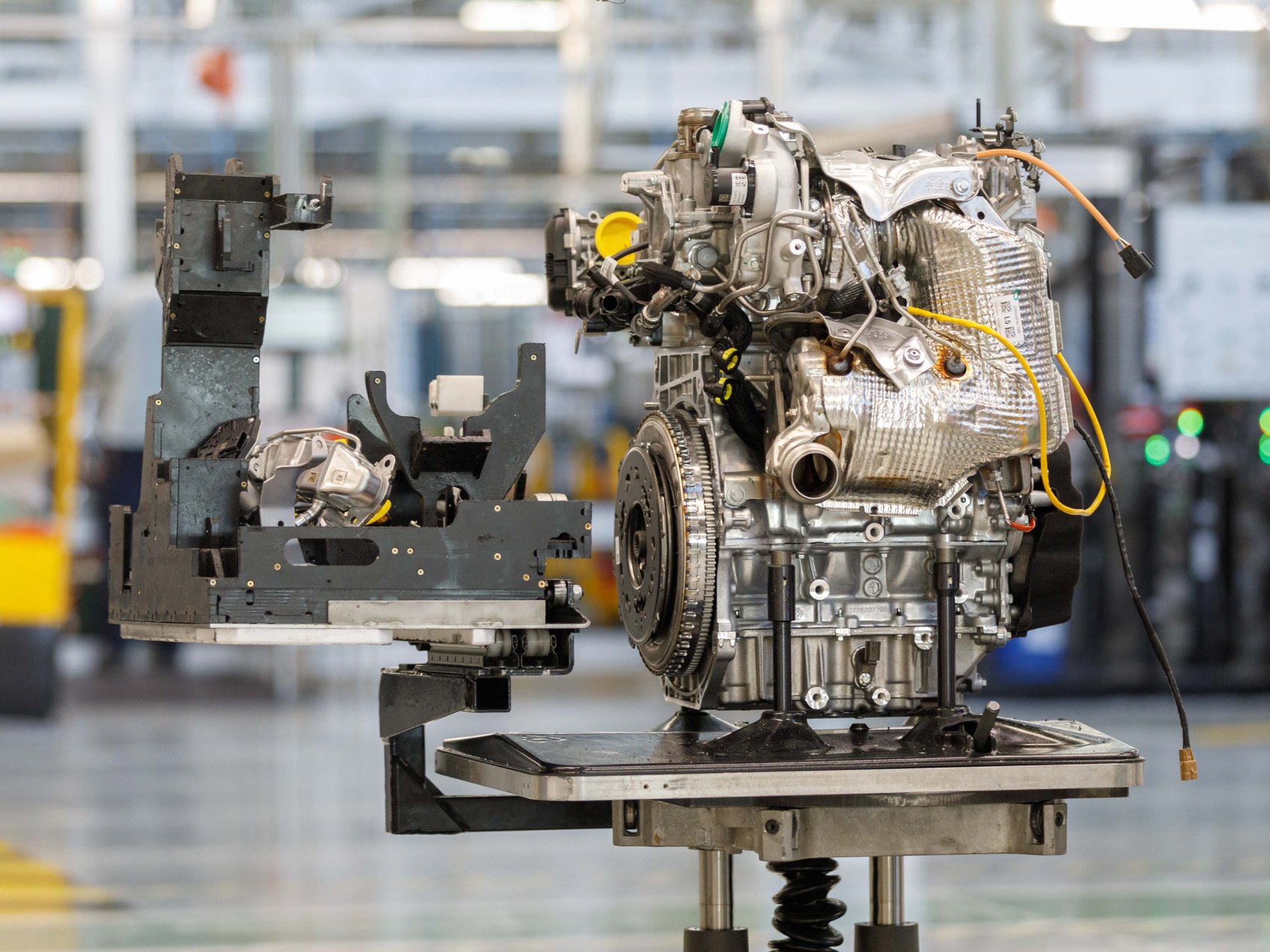
HORSE Powertrain Solutions, a division of HORSE Powertrain Limited and a leader in innovative and low emissions powertrain systems, has started a production run of 1.2-litre, 3-cylinder turbocharged petrol engines for use in plug-in hybrid-electric vehicles (PHEVs).
The proven HORSE ‘HR12’ engine can deliver peak power of 110kW (152PS) and maximum torque of 230Nm. The new PHEV-optimised HR12 units will be produced at HORSE’s plant at Valladolid. There, HORSE is initially targeting production of 1,200 units per month, with a maximum possible production capacity of 6,875 engines per month. The HR12 PHEV variant will be first used in the upcoming Renault Rafale E-Tech 4×4 Hybrid.
Development of the HR12’s PHEV variant began in July 2021, with HORSE having invested €4 million in its Valladolid plant to modify and scale its assembly line. This has included a €260,000 investment in people and staff, creating 345 jobs.
Patrice Haettel, Chief Executive Officer at HORSE, said: “This HR12 is the first plug-in hybrid engine manufactured at our Valladolid facility and the second produced by HORSE globally. This is a major landmark for our team, and proof of how HORSE’s internal combustion engine expertise can facilitate market-leading, low-emission mobility solutions. With outstanding range and efficiency, this PHEV architecture showcase the direction of the automotive industry and the value of HORSE’s indispensable technology leadership to our partners.”
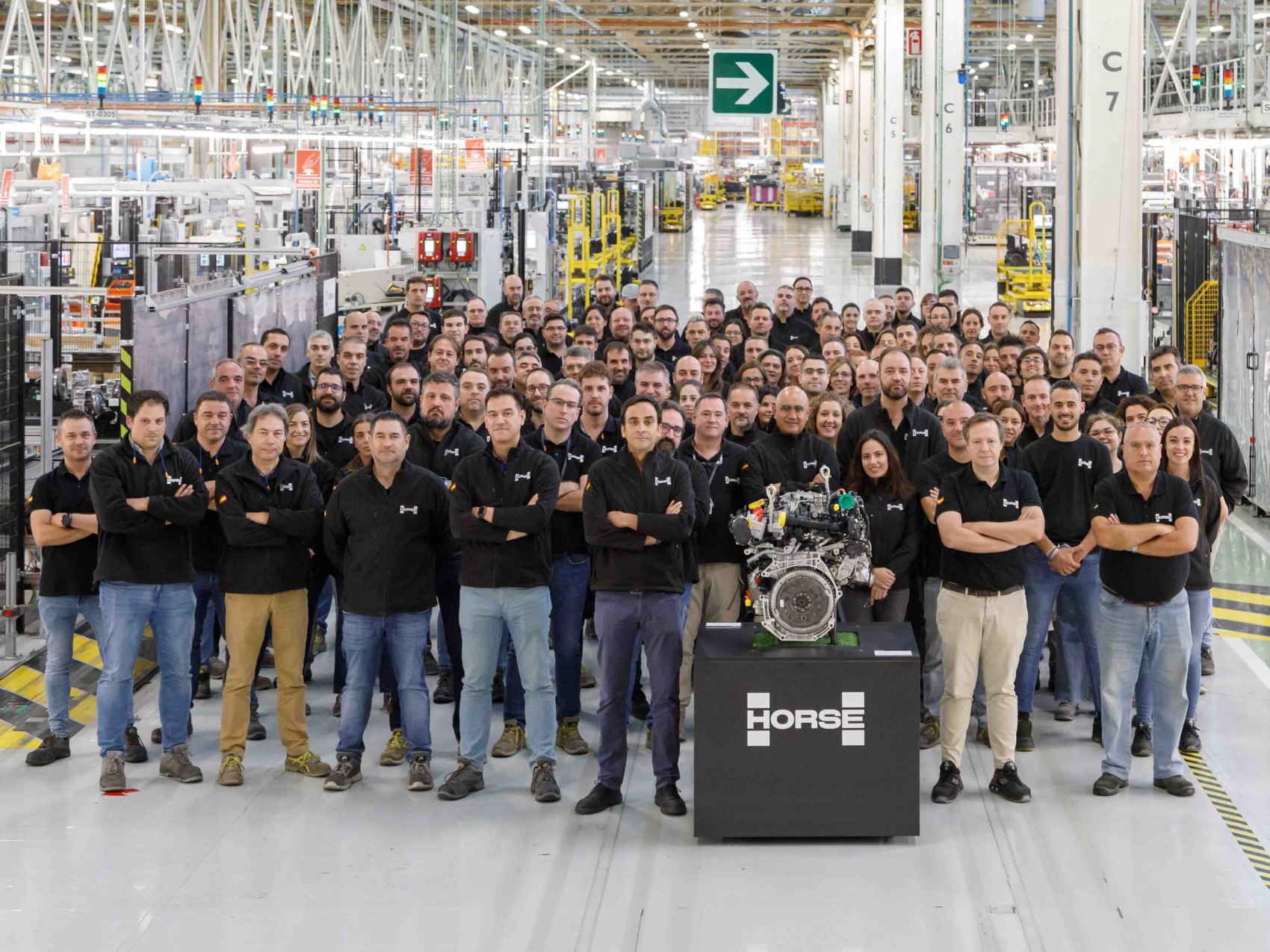
Leading PHEV powertrain
Alongside the HR12 internal combustion engine, the complete powertrain unit will also feature three electric motors – two main, and one secondary:
- the first main electric motor on the front axle, delivering 50kW of power and 205Nm of torque
- the second main electric motor on the rear axle, delivering 100kW and 195Nm
- a secondary HSG (High-voltage Starter Generator) electric motor producing 25kW and 50Nm
Altogether, this will mean the PHEV’s maximum power output will be over 220kW (300hp), driven by a specially adapted and clutchless multi-mode gearbox. The PHEV’s energy will be stored in a 400-volt lithium-ion battery, with a total capacity of 22kWh. Altogether, this means the powertrain will deliver a pure-electric range of over 100km for the Rafale E-Tech 4×4 Hybrid.
The PHEV’s superior efficiency will mean that the new Rafale 4×4 will achieve superior emissions performance. In electric mode, it will achieve an average fuel consumption of just 0.7 litres per 100km, with CO2 emissions of only 15g/km.
HORSE: a leader in automotive innovation
HORSE was created to provide highly efficient, low-emission engines, transmissions, and technologies to meet the varying power generation needs around the world. HORSE operates eight production plants across seven countries, three R&D centres and a head office based in Madrid, Spain – the company produces 3.2 million units per year for its customers around the world.
DOWNLOAD DOCUMENT
16 SEP. 2024
HORSE partners with Lecar to deliver passenger car range extender engine
– HORSE will supply 12,000 1.0-litre 3-cylinder “HR10” engines per year to Lecar, Brazil’s newest passenger car automaker
– Engines to be used in Lecar 459 Hybrid, a new Extended Range Electric Vehicle (EREV) targeted for launch in 2026
– First application of the HORSE engines for passenger car Range Extender, following supply for light commercial vehicles customers in the region
- HORSE is a division of HORSE Powertrain Limited, a global leader in hybrid and combustion powertrain solutions across 17 plants and 5 R&D centres
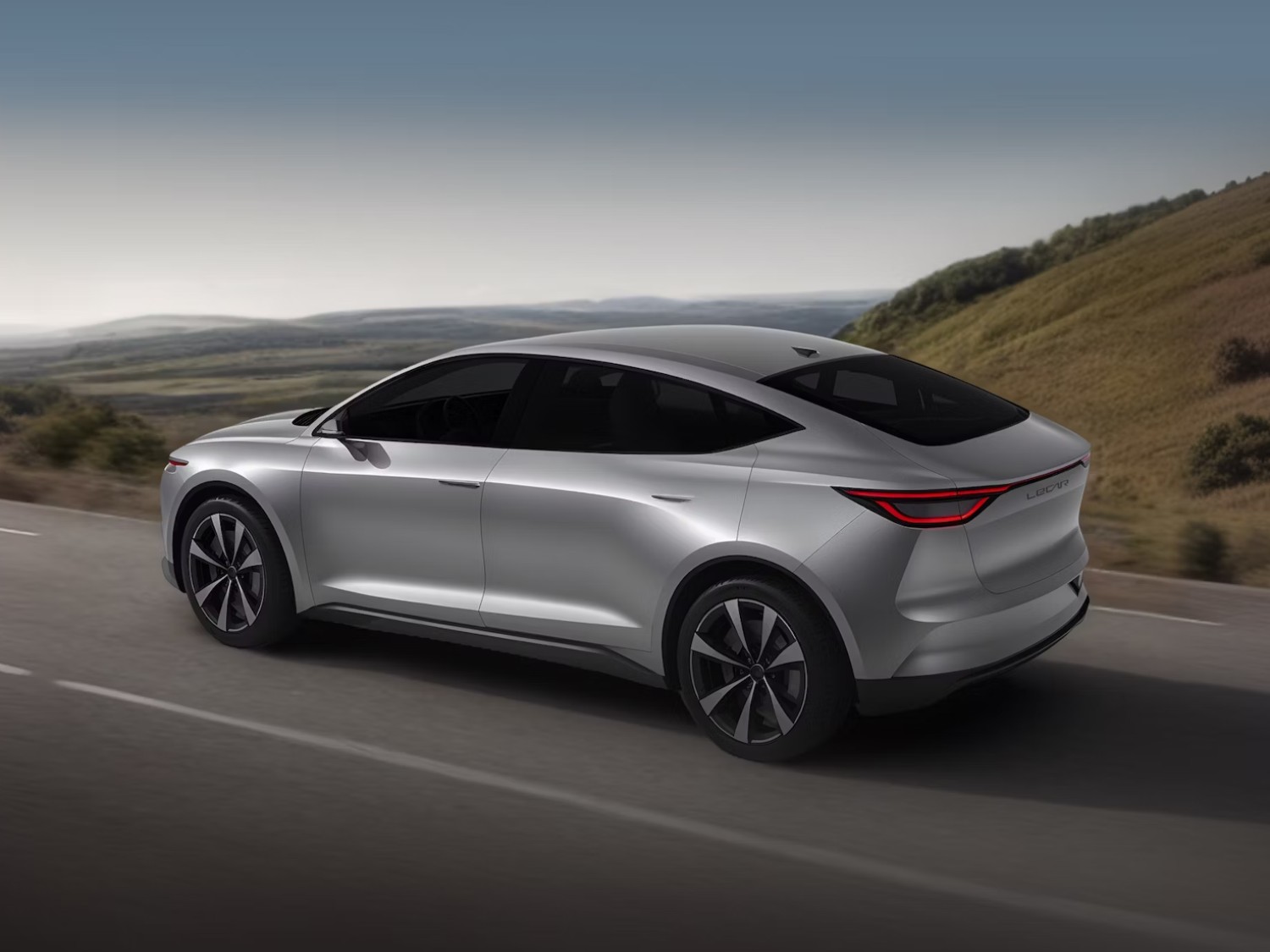
HORSE, a leader in innovative and low emissions powertrain systems, has today signed its first agreement to produce Extended Range Electric Vehicle (EREV) engines for a passenger vehicle: the Lecar 459 Hybrid.
Set to launch in 2026, the Lecar 459 Hybrid is the first vehicle from Lecar, Brazil’s newest home-grown electric vehicle (EV) automaker. Founded by Brazilian entrepreneur Flávio Figueiredo Assis, Lecar will introduce a new range of sophisticated and affordable EV models targeted at domestic audiences.
HORSE will initially supply Lecar with 12,000 units of its 1.0-litre 3-cylinder ‘HR10’ engines annually, with room to supply more as demand increases. The HR10 engines are tailored to run on low-emissions gasoline and ethanol flex fuels, which are a staple of the Brazilian market.
The HR10 units will serve as the combustion engine within the Lecar 459 Hybrid’s Range Extender powertrain. This leverages the HR10’s proven success within HORSE’s own Range Extender solution for light commercial vehicles.
Matias Giannini, Chief Executive Officer at HORSE Powertrain Limited, said: “This is a tremendous opportunity for HORSE, Lecar, and Brazilian motorists. For Lecar this agreement allows them the opportunity to leverage HORSE’s proven HR10 engine for a passenger EREV, following the HR10’s successful deployment in Range Extender solutions for light commercial vehicles.
“For HORSE, this is a monumental first step into providing combustion engines for passenger vehicle Range Extenders. This deal signals our commitment to Brazil, one of the world’s most exciting automotive markets. It also our signals our relentless commitment to innovation in EREVs, one of the fastest-growing vehicle categories globally – and our ability to support brands and OEMs developing both EVs and combustion engine vehicles.”
Best-of-both-world powertrain
In contrast to traditional PHEVs, the combustion engine of an EREV never directly drives the vehicle’s wheels – instead providing charge to the vehicle’s battery via an on-board electric generator.
This allows the combustion engine to run at its highest-efficiency state, minimising fuel consumption and emissions. When its battery is fully charged, the EREV’s engine will automatically be turned off.
The battery can also be charged in a similar manner to any other EV, using a public charger or domestic power supply. When used with low-carbon fuels, such as the flex fuels popular in the Brazilian market, this means that the cradle-to-grave footprint of the EREV is comparable to an equivalent long-range EV.
Patrice Haettel, Chief Executive Officer at HORSE, said: “HORSE was a natural partner for Lecar’s new hybrid passenger car. Our HR10 range extender engine is already at the heart of a light commercial vehicle, built in our rapidly growing operation in Curitiba, so it is proven technology in the market.
“Our footprint made us the perfect supplier for Lecar’s vision to create a truly home-grown Brazilian EV. This is a significant milestone for HORSE as it continues to deliver on our strategy of developing tailor-made solutions for every market. We have once again demonstrated our technology and industry leadership, and I am extremely proud of the HORSE teams across the world that have contributed to this engineering and commercial success.”
Tried-and-tested technology
This agreement follows the first Lecar 459 Hybrid prototype in August, which saw the company purchase its very first HR10 unit for testing and configuration in the test vehicle.
HORSE’s HR10 engine produces up to 85kW of power and 200Nm of torque thanks to its direct fuel injection, double overhead camshafts, and turbocharger. Produced at HORSE’s plant in Curitiba, Brazil, the HR10 is currently used in HORSE’s own Range Extender solution for light commercial vehicles.
Alongside HORSE’s HR10 engine, the Lecar 459 Hybrid will utilise an electric generator from WEG – HORSE’s electric component partner for its fully-integrated light commercial vehicle Range Extender solution.
Flávio Figueiredo Assis, Founder and Chief Executive Officer at Lecar, said: “Our team has an incredibly ambitious plan to develop and deliver the Lecar 459 Hybrid, Brazil’s first home-grown EV. To achieve this, HORSE is the ideal partner for us – along with being a world-class supplier of industry-leading combustion engines, HORSE’s production footprint in Brazil is in perfect alignment with Lecar’s vision to revolutionise the Brazilian car market with domestically-produced solutions.”
HORSE: a leader in automotive innovation
HORSE was created to provide highly efficient, low-emission engines, transmissions, and technologies to meet the varying power generation needs around the world. HORSE operates eight production plants across seven countries, three R&D centres and a head office based in Madrid, Spain – the company produces 3.2 million units per year for its customers around the world.
DOWNLOAD DOCUMENT
11 SEP. 2024
HORSE invests €32.8 million in energy-efficient cylinder head casting
– HORSE to invest in gravity-casting process to produce aluminium cylinder heads at its Curitiba plant in Brazil
– New cylinder head production facility localises supply chain for HORSE’s turbo flex fuel HR10 and HR13 engines
– Production line forecast to produce 210,000 cylinders annually and create 60 new jobs by 2026
– Further investment made in Curitiba’s engine testing and validation capabilities to accommodate new output
– HORSE is a division of HORSE Powertrain Limited, a global leader in hybrid and combustion powertrain solutions across 17 plants and 5 R&D centres
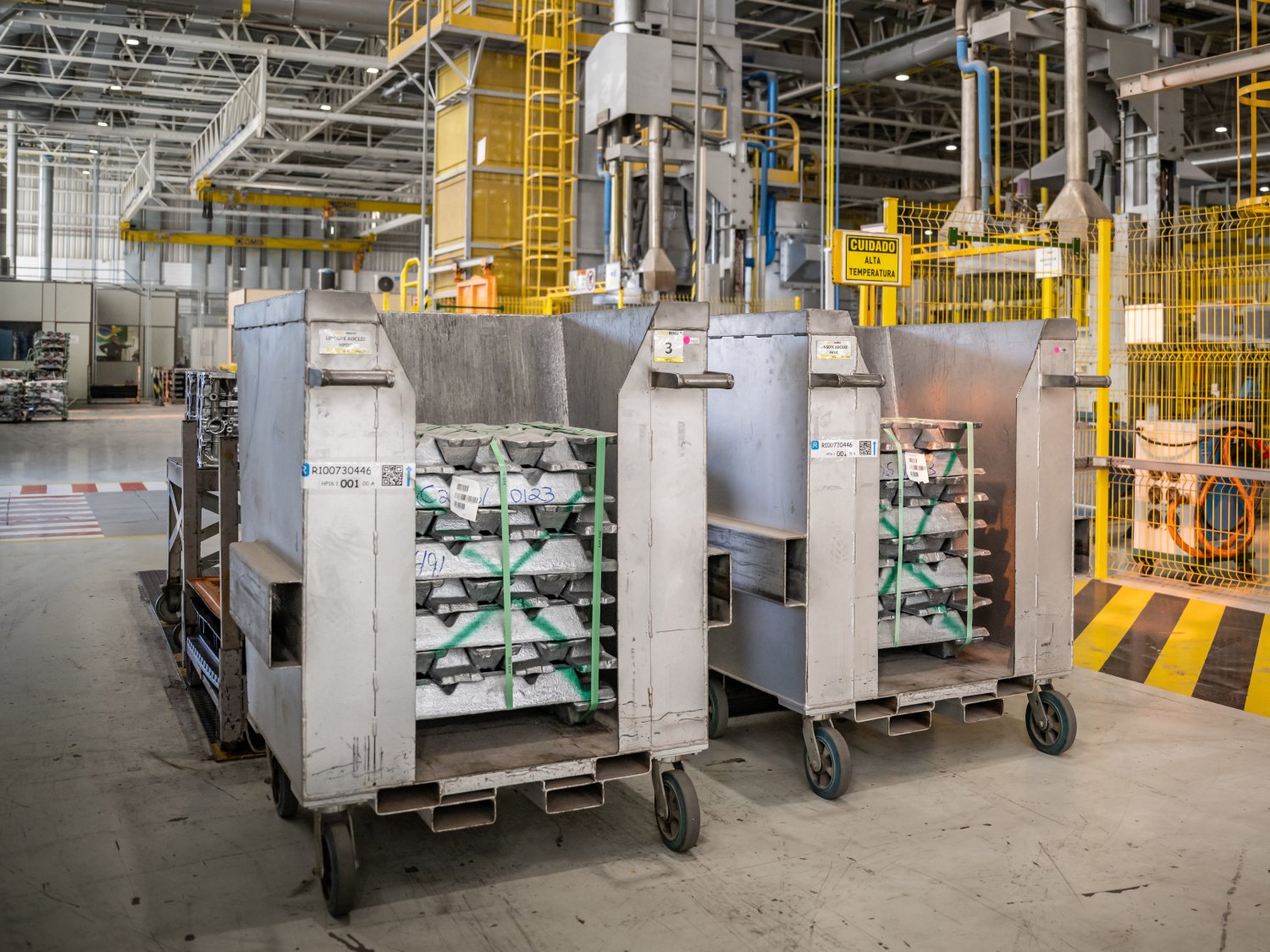
HORSE, a leader in innovative and low emissions powertrain systems, will invest in a new state-of-the-art production line to cast aluminium engine cylinder heads at its Curitiba plant in Brazil.
This new facility will use a tilting gravity casting process to produce aluminium cylinder heads for the company’s 1.0-litre and 1.3-litre flex fuel engines.
Forecast to cast 210,000 cylinder heads annually, HORSE will invest €26.3 million in the new automated production line, creating 60 new permanent jobs by 2026. HORSE will also be investing another €6.5 million in the Curitiba plant’s testing and validation capabilities to correspond with the growth in production volume. The new line is planned to be fully operational by October 2026.
Antonio Vaz, Chief Process Engineering Officer at HORSE, said: “By investing over €30 million in cylinder head production at Curitiba, we’re further localising the supply chain for some of our most valuable engines for the South American market. This new line also pioneers some of the most energy-efficient casting methods in the industry, with zero waste to landfill. It signals our commitment to South America and to next-generation processes at scale.”
Pioneering new processes
Curitiba’s new line will be HORSE’s first worldwide to use gravity casting for cylinder production, a highly efficient process that delivers components with outstanding mechanical and material performance.
In combination with the use of sustainably sourced inorganic sand, the new line will produce zero waste for landfill – all production waste can be re-processed and recycled.
Powering next-generation engines
Curitiba’s new line will produce cylinder heads for HORSE’s HR10 and HR13 turbo petrol engines. Tailored to the unique needs of the South American market, both the 3-cylinder 1.0-litre ‘HR10’ and 4-cylinder 1.3-litre ‘HR13’ engines can be run on both gasoline and ethanol, supporting the widespread use of flex fuels in Latin America. HORSE plans to produce both engines domestically at its Curitiba plant by the end of 2024.
Both engines use a delta-shaped cylinder head to save mass and space, lower their centre of gravity, and improve thermal management of the engine. Exhaust manifolds are directly cast into the head for faster turbo response and exceptional low speed torque delivery.
This new investment will enable cylinder heads for both the HR10 and HR13 engines to be entirely domestically produced at the Curitiba plant, localising the supply chain for these engines. It follows a €16 million investment in November 2023 to produce the HR10 engine at Curitiba.
Wesley Palma, Operations Director at HORSE Curitiba, said: “This investment recognises Brazil’s ever-growing importance to HORSE and the global automotive industry. Building on our previous investments to produce the HR10 engine in Brazil, this new initiative will further localise production for both our HR10 and HR13 engines with domestically cast cylinder heads. This will help us streamline our supply chain and further reinforce Brazil’s role as a critical hub for automotive innovation.”
HORSE: a leader in automotive innovation
HORSE was created to provide highly efficient, low-emission engines, transmissions, and technologies to meet the varying power generation needs around the world. HORSE operates eight production plants across seven countries, three R&D centres and a head office based in Madrid, Spain – the company produces 3.2 million units per year for its customers around the world.
DOWNLOAD DOCUMENT
03 SEP. 2024
HORSE scales production of powerful and efficient turbo flex fuel engines for South America
– 3- and 4-cylinder flex fuel engines tailored for South American region
– Exceptional power, efficiency and emissions with cutting-edge technology
– Designed to run on ethanol to meet the demands of the Brazilian market
– Outstanding performance achieved via electronically-controlled direct injection turbo
– Powertrains will be built at HORSE’s advanced Curitiba production facility
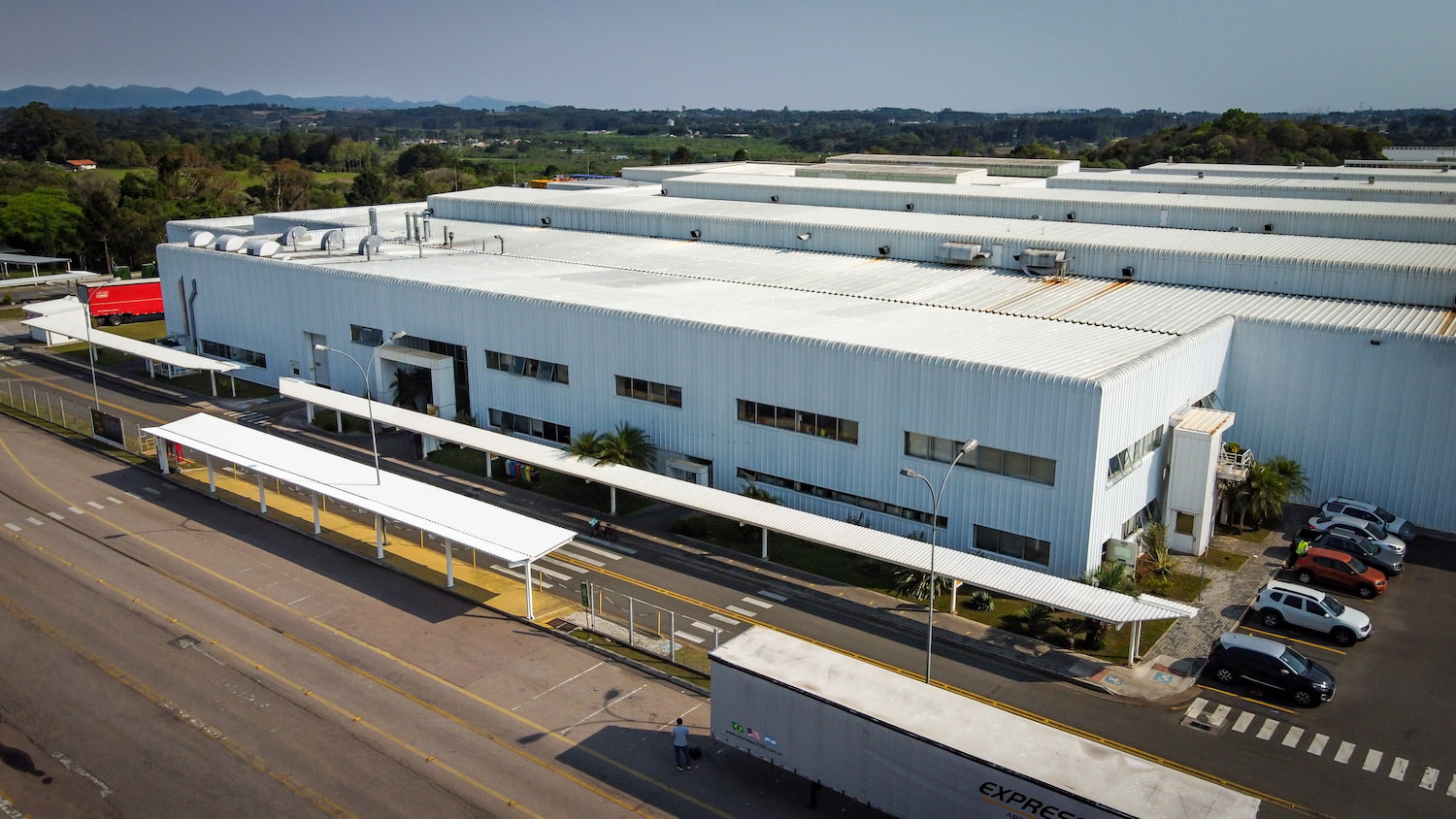
HORSE, a global leader in innovative and low emissions powertrain systems, has announced that it is bringing production of its powerful and efficient 1.3-litre Turbo Flex Fuel engine to Brazil, following the successful start of production of 1.0-litre models in Brazil earlier this year. Following the proven performance of these engines in the Brazilian market, HORSE plans to start producing these engines domestically at its Curitiba plant by 2024.
Tailored for the unique needs of the South American market, these advanced units deliver outstanding power, torque, efficiency and emissions. These Turbo Flex engines can be run on both gasoline and sustainable Ethanol, plus each is Proconve L7-compliant (equivalent to Euro6d) and are already in the process of becoming certified for the upcoming stringent L8 standards.
- The 1.0-litre three-cylinder unit, codenamed ‘HR10’, delivers peak power of 125PS (92kW) and a maximum of 220Nm of torque, 90% of which is available at as little as 1,750rpm for unrivalled throttle response in all driving conditions.
- The 1.3-litre four-cylinder unit, codenamed ‘HR13’, delivers peak power of 170PS (125kW) and a maximum of 270Nm of torque at just 1,600rpm
More than 170,000 hours of development have been dedicated to deliver the 1.0-litre Turbo Flex engine alone, so it can meet the exacting demand of the South American consumers. HORSE’s cutting-edge plant at Curitiba, Brazil will have the capacity to produce 500,000 engines annually.
Following a R$100 million investment in the Curitiba facility, production of the HR13 will begin alongside the HR10 in 2025.
Guillaume Tuffier, Director of Powertrain Strategy & Advanced Engineering at HORSE Powertrain Solutions said: “When we say that we’re creating tailormade powertrain solutions for markets around the globe, we really mean it. Producing HR10 and HR13 in Brazil is a perfect example of us taking advantage of local expertise to cater to local demand. With outstanding driving characteristics, seamless dual-fuel running and exceptional quality, the HR10 and HR13 are ideal engines for the Brazilian market”.
Outstanding Efficiency
Both the HR10 and HR13 feature a Formula One-inspired Diamond-Like Carbon (DLC) coating for the moving parts of the cylinder head as well as the piston rings and pins. This advanced nano technology reduces friction for enhanced fuel efficiency.
The cylinder walls of the lightweight aluminium engine block benefit from a Bore Spray Coating (BSC), which allows faster warm-up from cold and alone results in a reduction in emissions and consumption of 1 per cent.
Further fuel-saving features include friction-reducing polymer surface treatment for the crankshaft components and a Reflex-equipped Start & Stop system, which can shut off the engine before the vehicle comes to a stop for even greater efficiency.
Cutting edge technology
With an innovative Delta-shaped cylinder head, both these engines are more compact, lighter and has a lower centre of gravity than rival engines. Additionally, the exhaust manifold is cast into the head for faster turbo response and exceptional low speed torque delivery. The turbocharger for both engines is precisely controlled by an electronic wastegate, providing a maximum boost pressure of 1.5bar for the HR10 and 1.4bar for the HR13.
Power and efficiency are enhanced by continuous variation of the exhaust valve timing by an electronically-actuated, double-valve control shaft in the cylinder head. Not only does it allow for more efficient combustion and greater performance, the controller uses roller bearings to further reduce friction.
Both HR10 and HR13 benefit from a bespoke direct injection system that’s been developed specially for ethanol fuel use. Each cylinder in both engines is accompanied by a centrally mounted six-hole injectors operating at 200bar pressure, tailored for exceptional fuel atomisation that delivers effortless power and torque without impacting fuel efficiency.
HORSE: a leader in automotive innovation
HORSE was created to provide highly efficient, low-emission engines, transmissions, and technologies to meet the varying power generation needs around the world. HORSE operates eight production plants across seven countries, three R&D centres and a head office based in Madrid, Spain – the company produces 3.2 million units per year for its customers around the world.
DOWNLOAD DOCUMENT
14 JUN. 2024
HORSE and WEG sign memorandum of understanding for powertrain partnership
– R&D partnership between HORSE and WEG focuses on development of Range Extender technology for light commercial and heavy duty vehicles.
– As part of the agreement, WEG to supply electric generators, e-motors, electrical inverters and battery packs
– Range Extender powertrains also can use bioethanol and flex fuels, allowing the vehicle to achieve comparable emissions to fully electric vehicles
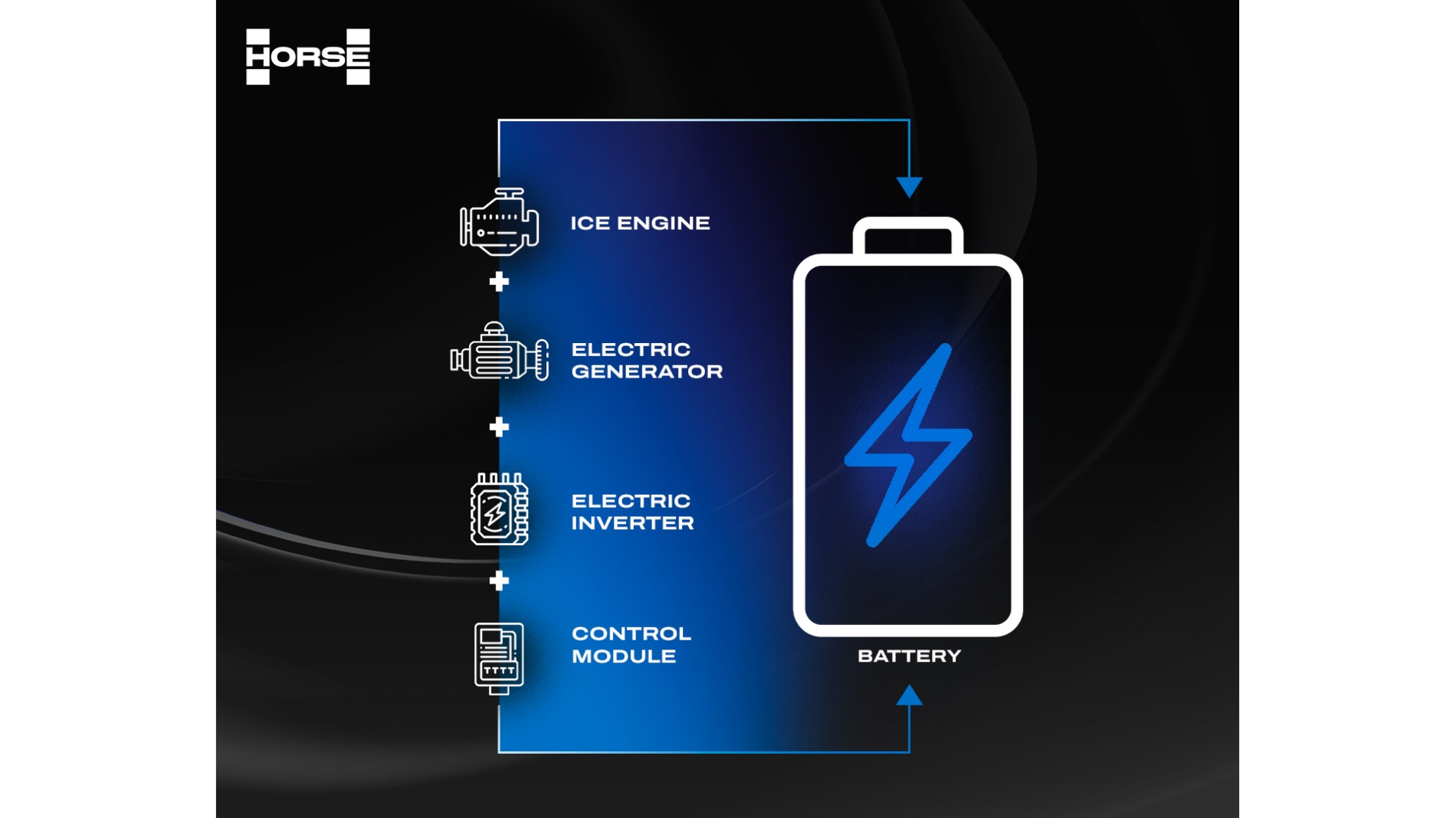
HORSE, a global leader in innovative and low emissions powertrain systems, has signed a memorandum of understanding (MOU) with leading Brazilian electronics manufacturer, WEG for a Research & Development partnership on its new Range Extender powertrain. This commercial partnership is HORSE’s first as a division of HORSE Powertrain Ltd.
As part of this agreement, HORSE and WEG will jointly-develop a market-leading Range Extender powertrain for light commercial and heavy duty vehicles, with WEG supplying the key components for the technology.
Upon completion of the R&D study, HORSE will become the system owner and supplier to customers.
HORSE will own the electronic architecture of the Range Extender, integrating components within existing requirements, as well as supplying the 1.0-litre ‘HR10’ engine and Control Module. WEG will supply the electric generators, e-motors, and electrical inverters.
Julien Faure, Chief Technology Officer at HORSE, said: “HORSE is focused on delivering decarbonisation technologies around the world, and this partnership with WEG will help to democratise the Range Extender powertrain solution. Working with a world-class electrical technology provider like WEG demonstrates our ability to create world-class powertrain solutions for the world’s differing needs and technical requirements.”
A Range Extender is made up of six key modules:
- The combustion engine, which generates mechanical energy that powers the electric generator.
- The electric generator, which converts mechanical energy from the engine into electric charge for the battery.
- The electric inverter, which converts direct current into alternating current, and enables communications between electronic components.
- The electronic control unit, which issues real-time instructions for vehicle components and electronics.
- The e-motor, which converts charge from the battery into mechanical traction for vehicle propulsion, as well as providing regenerative braking functionality.
- The battery, which stores the electrical energy originating from the electric generator and e-motor.
This partnership with WEG will grant HORSE preferential access to these critical components for its fully integrated Range Extender units, allowing continuous supply for customers. Designed for both light commercial and heavy duty vehicles, the Range Extender features an optimised battery pack and HORSE’s 85kW 1.0-litre, three-cylinder ‘HR10’ engine. The HR10 can use flex fuels, allowing the Range Extender’s total emissions profile to be comparable to that of a fully electric vehicle.
The benefit of a Range Extender is the engine constantly operates in its most efficient operating window, minimising fuel consumption and emissions.
HORSE: a leader in automotive innovation
HORSE was created to provide highly efficient, low-emission engines, transmissions, and technologies to meet the varying power generation needs around the world. HORSE operates eight production plants across seven countries, three R&D centres and a head office based in Madrid, Spain – the company produces 3.2 million units per year for its customers around the world.
DOWNLOAD DOCUMENT
10 JUN. 2024
HORSE commits to ‘2030 sustainability plan’
– HORSE unveils stringent ESG sustainability commitments as it works towards net zero by 2050
– Commitment to Net Zero Standard already submitted and approved by SBTi
– Far-reaching action plan spans network, operations and product range
– Key pillar aimed at strengthening environmental sustainability throughout the supply chain
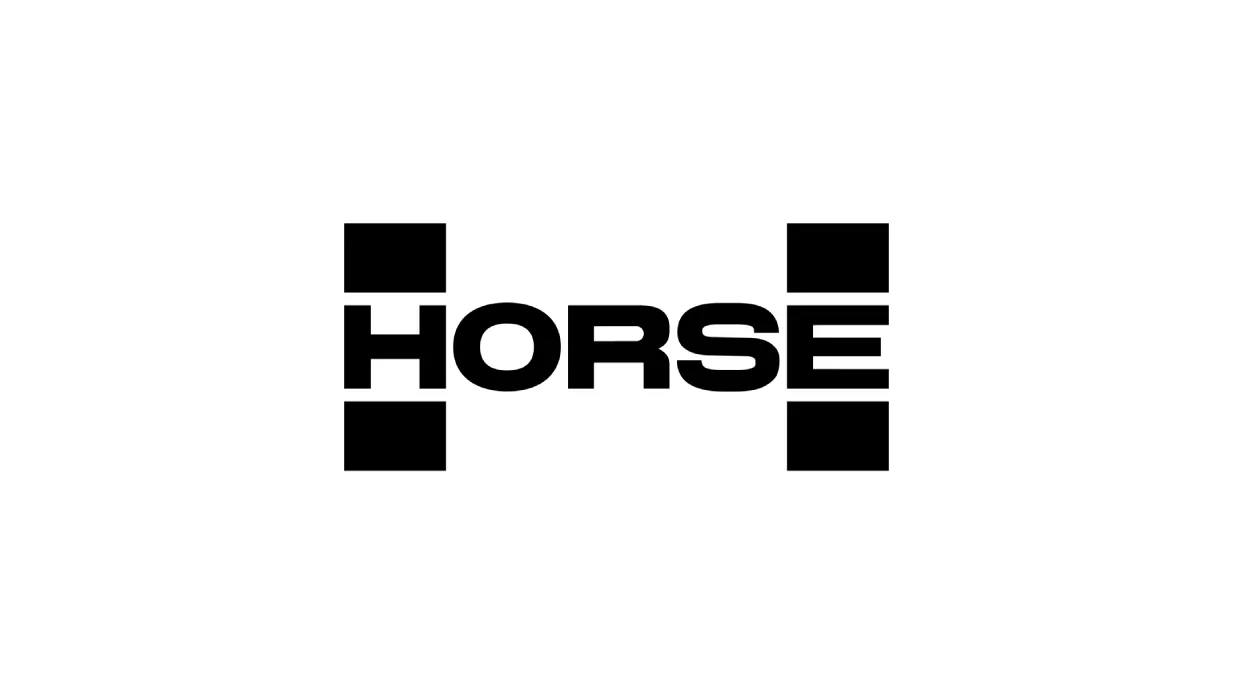
HORSE, a global leader in innovative and low emissions powertrain systems, has launched its ambitious ‘2030 Sustainability Plan’, which commits the business to a wide range of stringent carbon-reduction and social-impact targets.
The company has already begun pursuing its pledges in its Environmental, Social and Governance (ESG) plan, with a commitment to Net Zero Standard already submitted to the SBTi (Science Based Targets initiative). The ultimate target is to become a carbon net zero sustainable mobility company by 2050.
By 2030, there are a number of key milestones that will already have been met by the company, covering operations, product range, as well as reducing emissions through the supply network.
Low emissions powertrains
A cornerstone of HORSE’s commitment is ensuring that 60% of total global sales are low-carbon engines by the end of the decade; with hybrid and flex fuel powertrains being joined by next-generation hybrid, lightweight range extenders, and synthetic and hydrogen-fuelled power solutions.
This commitment to sales of low carbon engines will result in a significant 29% decrease in emissions from sold product per kilometre (well to wheel), compared to 2023.
To achieve this, HORSE will increase the number of hybrid electric and plug-in hybrid powertrains it builds, plus add to its flex-fuel units. This includes E85 and E100 ethanol engines, as well as those powered by Compressed Natural Gas (CNG) and Liquified Petroleum Gas (LPG).
Patrice Haettel, Chief Executive Officer at HORSE, said: “We have embedded sustainability into everything we do, it is what will defines us: we are a company with a clear and firm commitment to both people and the planet. Our technologies contribute to the reduction of mobility’s carbon footprint and the energy transition needed to drive decarbonisation. We believe that we must do more than simply create low-emission propulsion solutions. We have to act as a transformation agent within the automotive sector to provide sustainable, responsible, and inclusive mobility.”
“As we move towards our 2050 goal of becoming carbon net zero, we understand there will be many challenges to overcome. However, with our spirit of innovation and expertise, along with a highly trained workforce, we are perfectly placed to achieve our ambitious goals over the coming decades.”
Positive production processes
The plan goes much further than just HORSE’s end product, with it also targeting reductions in carbon emissions at plants and its downstream network. This will result in a 42% reduction in scope 1 and 2 carbon emissions between 2023 and 2030.
By 2030, every HORSE facility around the world will use only renewable electricity to power operations. Currently, more than two-thirds of its factories already use renewable electricity.
Further improvements will be made to increase sustainability in the production process, with as much as 73% of the aluminium content being sourced from recycled materials, up from today’s figure of 66%. In addition, all production facilities will put in place a biodiversity assessment and planning processes that ensure a positive impact for the local environment.
People at its heart
At the heart of HORSE’s sustainability goals is an engaged, safe workforce that is fully committed to this journey. Within this commitment, all sites around the world will be certified under the Great Place to Work scheme.
HORSE has earmarked €3 million for social contribution projects in and around its production facilities. This funding will help empower employees and the local community to make positive impacts on their lives and nature.
Ethics as the guiding principle
HORSE will also ensure responsibility for sustainable production extends to its supply chain, with all partners being expected to meet its ESG requirements by 2030. These ethical and governance standards extend throughout its value chain and its commercial partnerships with third parties.
HORSE: a leader in Innovative Power Solutions
HORSE was created to provide highly efficient, low-emission engines, transmissions, and technologies to meet the varying power generation needs around the world. HORSE operates eight production plants across seven countries, three R&D centres and a head office based in Madrid, Spain – the company produces 3.2 million units per year for its customers around the world.
DOWNLOAD DOCUMENT
31 MAY. 2024
Renault Group and Geely announce the creation of leading Powertrain Technology Company, “HORSE Powertrain Limited”
– Following the agreements signed on July 11, 2023 by Renault Group and Geely, and after having obtained the approval of the relevant authorities, HORSE Powertrain Limited has been officially created on May 31, 2024 with each group holding 50% stake in the new company.
– The new company will lead the market for hybrid and combustion powertrain components and systems.
– Matias Giannini is appointed CEO of HORSE Powertrain limited. The Board of directors of HORSE Powertrain Limited will be chaired by Daniel Li and will have 6 directors with equal representation from its shareholders.
– HORSE Powertrain Limited expects to reach c. €15 billion in annual revenues and a production of c. 5 million powertrain units per year and will have as of day 1 a complete portfolio of state-of-the-art powertrain technologies for global partners including hybrid systems, internal combustion engines, transmissions, and battery solutions.
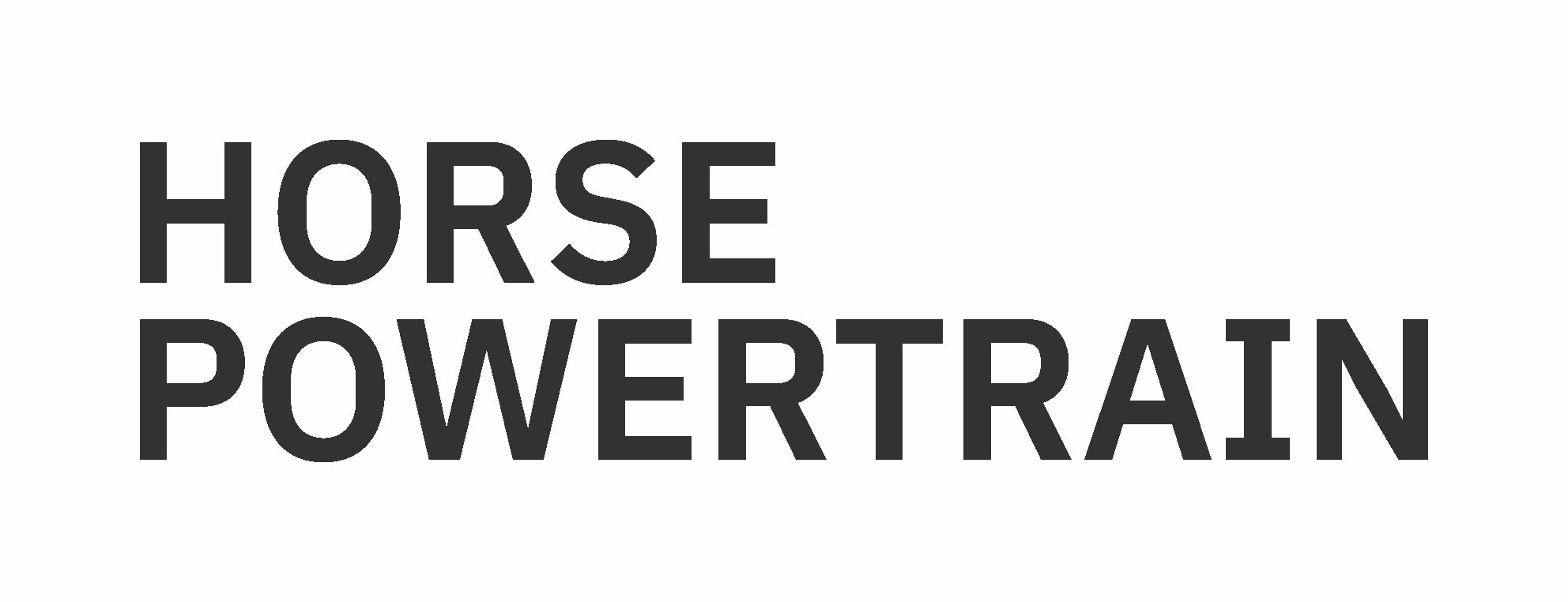
Following the joint venture agreement signed on July 11, 2023, and after having obtained the approval of the relevant authorities, Renault Group, Geely Holding Group (Geely Holding), Geely Automobile Holdings Limited (Geely Auto) (collectively referred to above as “Geely”) have officially created HORSE Powertrain Limited, headquartered in London, United Kingdom.
Luca de Meo, CEO Renault Group declared: “Today marks an important step in meeting the greatest challenges facing the automotive industry: the decarbonization of road transport. Partnering with a leading company like Geely to create a new player with the capability and expertise to develop ultra-low emission internal combustion engines and high economy hybrid technologies is key for the future. Through HORSE Powertrain, Renault Group can achieve worldwide leadership and scale in a sector representing more than 80% of its business. Together we will rise to meet the decarbonization challenge with innovation at the forefront of our operations.”
Eric Li, Geely Holding Chairman: “For the industry to reach net zero emissions in the next decades, global synergies, multiple technologies, and sharing of expertise, are crucial. That is why we are pleased that our partnership with Renault Group is reaching commercial reality today. HORSE Powertrain Limited will have the portfolio, scale and capacity to offer the low-emission solutions the automotive industry of tomorrow demands. Today’s launch marks a new chapter in sustainable mobility, and we at Geely are proud to play a part.”
Renault Group and Geely believe that a combination of various powertrain technologies is necessary, including highly efficient internal combustion engines (ICE), lower carbon e-fuels, and hydrogen, to achieve a successful decarbonization in a world where more than half of vehicles produced are expected to still rely on combustion engines by 2040.
A new player to disrupt the game and pave the way for ultra-low emission hybrid and combustion technologies.
HORSE Powertrain Limited will design, develop, produce, and sell all hybrid and combustion powertrain solutions and systems with state-of-the-art technologies including engines, transmissions, hybrid systems and batteries.
Thanks to this project, both Renault Group and Geely will benefit from immediate scale effect and market coverage enhancement. Supported by the transfer of Intellectual Property from Renault Group and Geely, HORSE Powertrain Limited is now fully autonomous in developing future powertrain technologies capable of addressing all market expectations, notably in the field of alternative fuels such as green methanol, ethanol, and hydrogen. The joint venture’s complementary product portfolio and regional footprint could offer solutions for 80% of the growing global hybrid & combustion powertrain market.
HORSE Powertrain will supply multiple industrial customers including Renault Group, Geely Auto, Volvo Cars, Proton, Nissan and Mitsubishi Motors Company. The company is ready to engage with customers and partners around the world to support them with end to end solutions in powertrain technologies and will welcome partners to further strengthen the value chain.
From Day One of its establishment, HORSE Powertrain Limited is worldwide leader in hybrid and combustion powertrain solutions with:
- 17 global plants
- 9 customers in 130 countries
- 5 R&D centers
- c.19,000 employees
- expected c. €15 billion in yearly revenues
- expected c.5 million units powertrain per year
- All types of hybrid solutions covered – full hybrids and long-range plug-in hybrids as well as internal combustion engines that use alternative fuels such as ethanol, methanol, LPG, CNG, H2 etc.
Governance structure
Renault Group and Geely, as funding shareholders of the powertrain company, have approved the global governance scheme as well as strategic appointments of HORSE Powertrain Limited.
Matias Giannini is appointed CEO of HORSE Powertrain Limited.
Lee Ma and Juan Ferrera are respectively appointed Chief Financial Officer and Chief Human Resources Officer of HORSE Powertrain Limited.
The management of the two subgroups Aurobay and Horse, bringing together the industrial know-how and assets of both companies remains unchanged: Ruiping Wang as CEO of Aurobay, based in Hangzhou Bay (China), Patrice Haettel CEO of Horse based in Madrid (Spain). They will directly report to Matias Giannini.
The board of directors of HORSE Powertrain Limited is composed of 6 members:
- Three directors from Geely: Daniel Li (Vice Chairman of Geely Auto and CEO of Geely Holding) will become chairman of the Board, Jerry Gan (CEO of Geely Auto Group) and Joe Zhang (Chief Financial Officer of Geely Holding).
- Three directors from Renault Group: François Provost (Chief Procurement, Partnerships and Public Affairs Officer), Gilles Le Borgne (Chief Technology Officer) and Denis Le Vot (CEO of Dacia and Chief Supply Chain Officer).
As of May 31, 2024, the respective operational entities of HORSE Powertrain Limited, namely Horse and Aurobay, will be deconsolidated respectively from Renault Group and Geely.
DOWNLOAD DOCUMENT
18 APR. 2024
HORSE reveals its pioneering fully digital ‘Matrix Flow’ production process
– HORSE unveils its innovative and fully digital Matrix Flow production line
– Cutting edge autonomous platforms replace traditional conveyor belt production line
– Pioneering technology used to build Power Electric Boxes for HEV and PHEV vehicles
– Advanced systems deliver greater flexibility and productivity in the move to electrification
– Huge energy savings of up to 50% as a result of faster and more streamlined processes
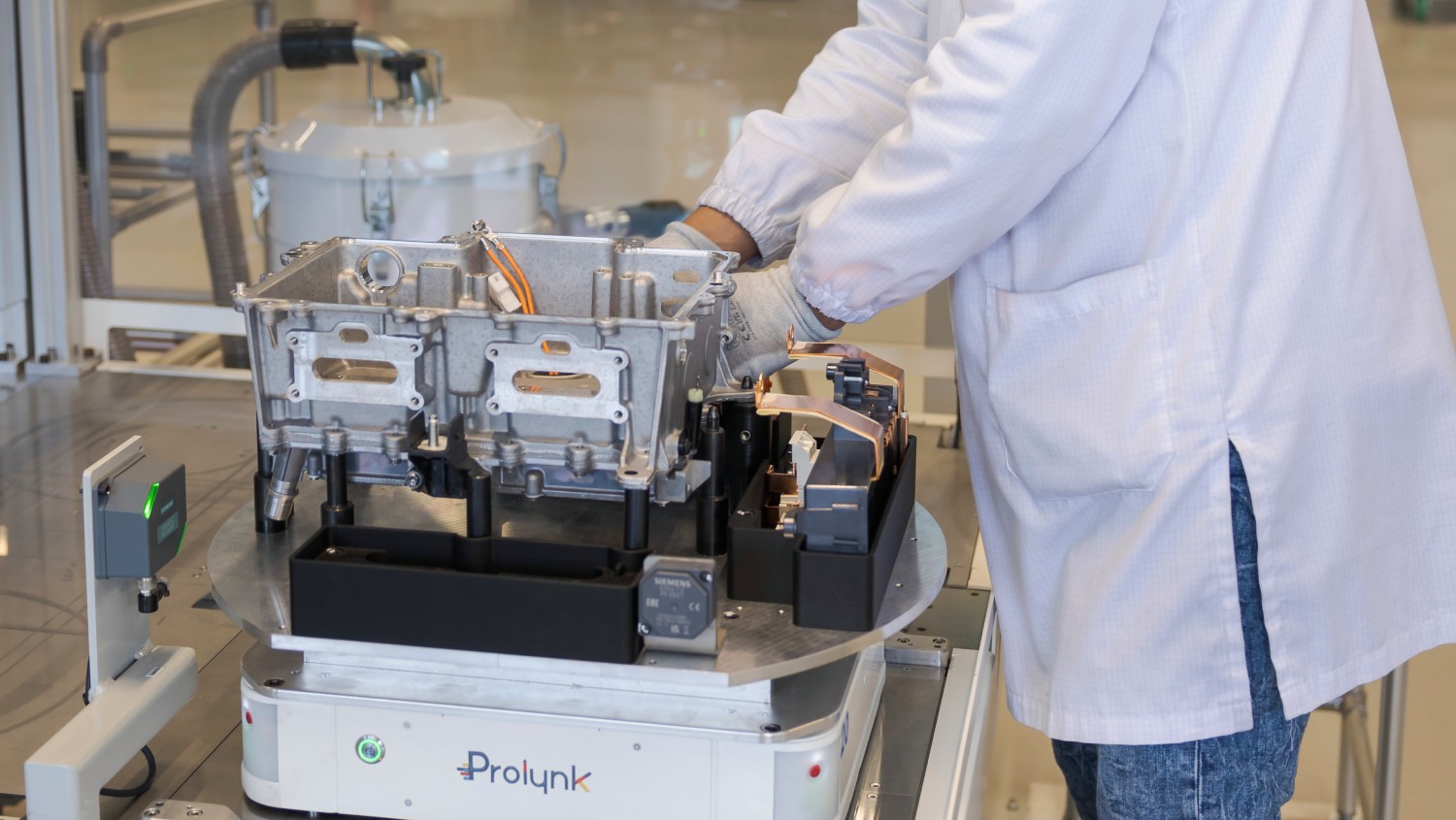
HORSE, a global leader in innovative and low emissions powertrain systems, is pioneering an advanced, fully digital automated production process aimed at enhancing productivity, quality and sustainability in its factories.
Known as Matrix Flow, the new process debuts in HORSE’s Aveiro plant in Portugal. It replaces the existing, sequential conveyor belt-based production system with a highly efficient fleet of autonomous platforms and work stations known as Mobile Programmable Cobots (MPCs).
Already used in the manufacture of electronic goods and by multi-national logistics firms, HORSE is one of the first companies to tailor the process for automotive powertrain production using it to construct the Power Electronic Box (PEB) that manage the electric motors in Hybrid Electric Vehicles (HEV) and Plug-in Hybrid Electric Vehicles (PHEV).
Antonio Vaz, Chief Process Engineering Officer at HORSE said: “Our new Matrix Flow Assembly line at Aveiro is a hugely significant moment for HORSE. This exciting development confirms our place as a global leader in powertrain development and production. By delivering unrivalled flexibility and efficiency, this fully digital production method allows us to be agile and responsive while continuing to deliver the highest quality products and meet our commitments to sustainable mobility.”
Developed in partnership with automated production specialists Prolynk (a project by OSE Group), these MPC can deliver the precise components and sub-assemblies needed to factory staff and robots at each stage of the production process. Up to 30 smaller MPC effectively act as mobile workstations and components kitting, ensuring employees always have the right parts and tools at the right time.
Managed by a carefully programmed fleet controller hub, the MPC wirelessly communicate with each other and can quickly adapt to changes in parts supply and production needs, delivering greater flexibility in the production process as well as huge reductions in costly downtime. It can also be quickly scaled up or down, allowing the factory to react quickly to changes in demand.
Production of PEB at the plant will start in the coming days, with an initial target of 150,000 units a year, rising to 200,000 by the end of 2024.
Enhanced Efficiency
By using the autonomous MPCs instead of a traditional sequential flow production line, HORSE has been able to reduce the physical footprint of its factory floor by 25%, and the size of the building overall by 30%.
With a smaller facility and streamlined production, HORSE has been able to slash energy use at the site by a significant 50%. Paper labels are also no longer required for any component as each is digitally identified, delivering more accurate and sustainable production.
Ready for an electrified future
HORSE’s Matrix Flow concept puts it at the forefront of production technology as the automotive industry transitions to a fully electrified future. Without the need for a fixed production line, HORSE can quickly and efficiently scale production up or down to accept updated components or even a completely new product.
The Aveiro facility has been designed to deliver a clean, sterile and electro-static discharge (ESD) environment, crucial to the production of high technology electric powertrains. Effectively creating a ‘cocoon’ around the production line, this approach ensures the quality of the products and the safety of the staff.
HORSE has also invested heavily in its production staff, providing training that allows them to adopt the latest techniques and technologies. For instance, the use of virtual reality goggles and bespoke software allows employees to quickly and safely adapt to any changes in the Matrix Flow production processes before they’re implemented.
HORSE: a leader in Innovative Powertrain Solutions
HORSE was created to provide highly efficient, low-emission engines, transmissions and technologies to meet the varying power generation needs around the world. HORSE is a truly global company, with eight production plants across seven countries, three R&D centres and a head office based in Madrid, Spain. The company produces 3.2 million units per year for its customers around the world.
Since its creation less than a year ago, HORSE has maintained an upward trajectory, thanks to its strong focus on R&D and cutting-edge technology as well as its ability to form new commercial partnerships.
DOWNLOAD DOCUMENT
16 APR. 2024
HORSE commences power electronics box production at Aveiro
– Production of Power Electronics Box begins today in Aveiro, Portugal, with production expected to reach 230,000 per annum from 2025.
– Power Electronic Box – redesigned with fewer wiring harnesses – integrates power inversion, conversion, control, and cooling systems into a single unit.
– New assembly line uses state-of-the-art technology for full digitalisation and innovative industry 4.0
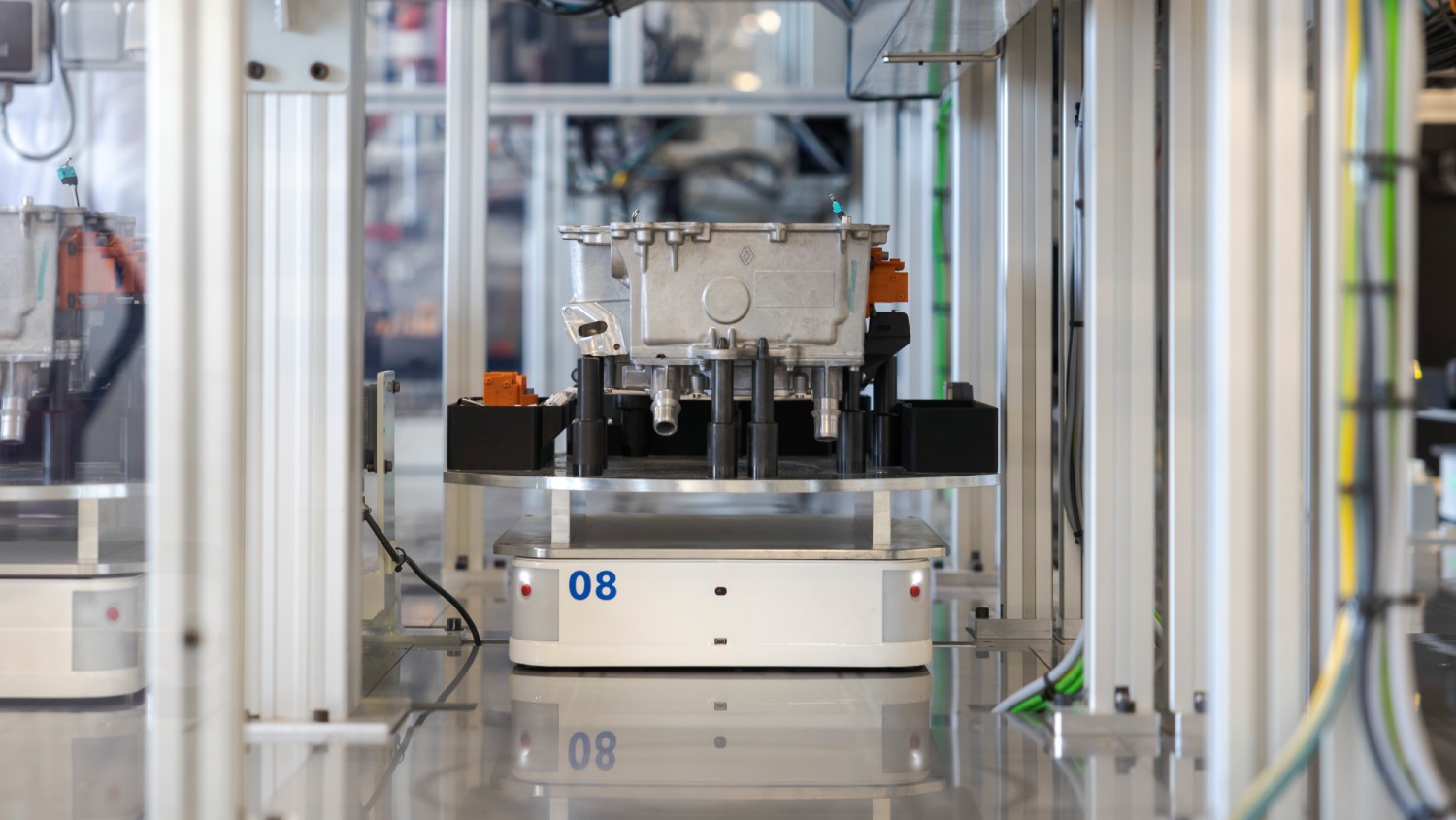
HORSE, a global leader in innovative and low emissions powertrain systems, today announces the start of production of its Power Electronics Box (PEBs) at its plant in Aveiro, Portugal.
The PEB is a major component in the value chain for hybrid vehicle powertrains and is responsible for managing the two electric motors in all of HORSE’s hybrid (HEV) and plug-in hybrid (PHEV) systems. The device, which has been redesigned simplifying components for increasing robustness and reliability, integrates several critical systems into a single unit, encompassing:
- Power inverter/converter, converting direct current (DC) from the High Voltage battery into alternating current (AC) for driving the electric motors of the powertrain.
- DC/DC converter, converting high-voltage DC battery energy into low-voltage DC to the 14V network for use in various sub-systems across the car, including lights, radio, and charge for the smaller 12V battery.
- Control electronics, providing real-time regulation for power distribution across the vehicle based on velocity and acceleration.
- Cooling, with the PEB ensuring that all components avoid overheating, maximising the unit’s service life and improving efficiency.
Patrice Haettel, Chief Executive Officer of HORSE, said: “The start of Power Electronic Box production in Aveiro marks a significant milestone as it signifies the transition towards electronic component manufacturing for HORSE in Portugal. Additionally, we are using an innovative production process which it enables us to have a significant competitive advantage. This substantially increases our production capacity, ensuring that we can deliver key hybrid vehicle technologies to our customers worldwide. The Aveiro production line enhances our flexibility and productivity while serving as a beacon of Industry 4.0, reaffirming our position as a leading provider of low-carbon combustion and hybrid powertrain systems.”
Production at Aveiro
HORSE’s plant in Aveiro, Portugal, was chosen to be the company’s site for PEB production owing to its industrial performance. With more than forty years of operational excellence in manufacturing gearboxes and engines, this new venture marks Aveiro’s first step into producing electronic components. It has a number of sustainability projects that reduce its carbon footprint, including having the largest private photovoltaic field in Portugal, as well as being situated in close proximity to its customers.
Raynald Joly, Plant Director at HORSE Aveiro, said: “With a 1,300-strong workforce, the Aveiro plant is an outstanding centre of skills and technology that’s ideally placed to serve customers as the primary site for manufacturing such an important product within hybrid vehicles. With over forty years as a world-leading automotive manufacturing site, this new production along with our ongoing transformation plan will confirm the status of HORSE Aveiro as a new innovative technology business unit for and beyond automotive industry.”
HORSE expects the Aveiro facility to produce 60,000 units on its new assembly line this year. The assembly line is the first at the plant to be converted into an electro-static discharge protected area (EPA), designed to minimise electro-static charge and ensure quality and safety. In 2025, HORSE expects the line to increase production to 230,000 PEB units. The project is the culmination of significant investment by HORSE, with the PEB project team having transformed a former warehouse into a cutting-edge electronics manufacturing site in less than one year.
In anticipation of production, HORSE has invested in state-of-the-art training for staff in Aveiro. Along with training for ESD-safe environments, staff working on the PEB assembly line have also trained on virtual reality (VR) simulations. The line itself leverages a range of modern industrial innovations: autonomous geolocation-powered platforms to carry parts across the workshop, full digital control of all operations, and real-time monitoring of all critical parameters.
HORSE: a leader in Innovative Powertrain Solutions
HORSE was created to provide highly efficient, low-emission engines, transmissions and technologies to meet the varying power generation needs around the world. HORSE is a truly global company, with eight production plants across seven countries, three R&D centres and a head office based in Madrid, Spain. The company produces 3.2 million units per year for its customers around the world.
Since its creation less than a year ago, HORSE has maintained an upward trajectory, thanks to its strong focus on R&D and cutting-edge technology as well as its ability to form new commercial partnerships.